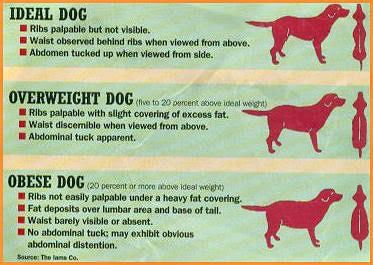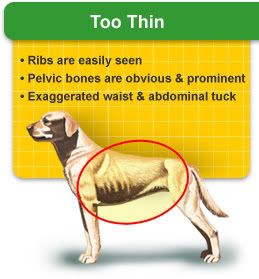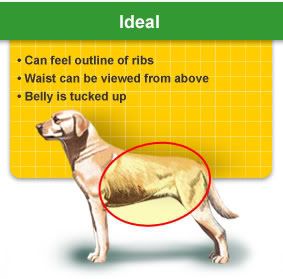



Why does it matter if your dog is overweight?
By Sue Averill
One of the biggest health concerns facing dogs today is obesity. Obesity is responsible for creating and aggravating serious problems in dogs. The good news is obesity is preventable and (mostly) reversible. The bad news is that owners have to change their habits because a dog's weight problem is not his fault, it's his owner's!
Overweight dogs that have conditions such as arthritis, hip dysplasia and over-angulated joints, (pasterns, hocks and stifles) suffer greater pain, which causes a greatly reduced quality of life. Obesity in dogs can cause stroke, diabetes, shortness of breath and heart attacks. Obesity can aggravate epilepsy. Many people with epileptic dogs feed them a no or low fat diet and can more easily manage their condition this way. Obese dogs get pressure sores from supporting too much weight on their elbows and hocks when they are laying down (which is most of the time). Young overweight dogs are prone to ligament and tendon injury when playing too hard; for example -- going to the park once or twice a week to chase the tennis ball or Frisbee. Obese dogs cannot easily control their own movements and are extremely prone to injuries caused by twisting and turning sharply and jumping; blown cruciate ligaments (knees) are the most common. The worst condition caused by obesity is simply this, a greatly reduced life-span and unnecessary suffering.
Like humans, dogs should check with their doctors before beginning a weight loss program. A thorough veterinary examination, including a thyroid function test, will reveal whether a dog is suffering from any medical problems. (Many overweight dogs suffer from low (hypo) thyroid function. This can be remedied with an inexpensive prescription costing $10-$12 per month). An overweight dog may have certain conditions that would be exacerbated by exercise. Severely dysplastic dogs may need to diet to get the weight off before they can begin gentle exercise to gain muscle support on their hip joints.
All other dogs may be fed a reduced amount of a high quality diet and exercised more!! Dogs should be fed twice daily. Feeding the same amount once daily can actually cause a dog to gain weight due to the starving\stuffing effect. The metabolism of a dog with an empty stomach twenty three hours out of the day slows, and then his system processes the food too efficiently when he finally does eat. Food must always be measured, and you should feed by “eye” not by what it says on the dog food label. The feeding instructions for most dog foods only guarantee that the food will keep laboratory (bred) dogs alive in a cage. Trust what you see, not what you read. Feeding a dog by “eye” means that you should always see a clearly defined waist (imagine an aerial view of your wet dog) and, while you should not see ribs, they should be easily felt when you press your hands against his sides. You need to be aware of his daily activity and be flexible in adjusting his food slightly up or down as needed. If you've been sick a week and you've only been letting your dog out to potty, subtract a small handful of food out of each meal. If you're hiking with him in the mountains for a week, add a little extra to each meal.
Overweight dogs, like people, benefit from consistent sustained aerobic activity. Sporadic hard exercise like chasing sticks or balls should be reserved for fit dogs. Fat dogs benefit most from power walking. Start slowly with a good strong ten-minute walk on flat terrain. Add a minute a day until you're up to half an hour. Once you get to that level begin adding different terrain, little hills or long gentle grades. (Remember that in the summer or hot climates, the best time to exercise a dog is in the morning, before the ground heats up. Dogs’ unprotected feet and tummies are close to the ground and the dog overheats faster.) As your dog's tolerance for exercise increases (of which you must be the careful judge) and his weight decreases, you can increase the time out walking or the difficulty of the terrain.
Always feed the highest quality food you can afford. Good food costs more, but there are benefits. You will feed less due to its quality ingredients. Less food “in” means less poops “out” to pick up. Most importantly, you will have an overall healthier dog. Stay away from “lite” foods. Most contain ingredients to add bulk without adding calories. Your dog would never eat “cellulose” (wood pulp!) or peanut hulls, given the choice. Do not use “fat burning” additives.
The following is a tried and true weight reducing diet used for many different breeds. For ease of writing I'll assume the dog is an average size Lab cross.
1. Buy him a smaller bowl.
2. After a.m. exercise, feed him 1/2 cup adult dog food with one of the following mixed in: 1/2 cup green beans, 1/2 cup carrots, 1/2 cup pumpkin, 1/2 cup zucchini [Note: To reduce the risk of bloat, you should not exercise your dog for 2 hours before, or 2 hours after, he eats]
3. Noon, feed him an apple [minus the seeds & stem] or big carrot
4. Evening, repeat a.m. meal
Veggies should be fresh or frozen and never canned (too much salt). You can experiment to find what your dog likes best, any high fiber low calorie veggie will do. The trick is to keep the dog ‘full’ without giving him any extra calories. This will keep his metabolism up and help him burn more calories. This is what “Lite” dog food attempts to do, often by using peculiar ingredients (when was the last time anyone you knew went on the ‘sawdust diet’?) or resorting to carbohydrates which don't contain fat but will eventually turn into fat in an inactive dog. Once your dog has achieved his goal weight, you need to find his feeding/exercise balance point. If you find both you and your healthier, fitter dog enjoy the amount of exercise you're currently doing, you can gradually add dog food and subtract veggies until the dog ‘holds’ his weight. If you want to exercise your dog less, you may have to feed lesser amounts of dog food long term.
We all regret that our pets never live quite long enough. If we really love our dogs we must, as their custodians, do everything we can to make sure they are healthy and comfortable during the time that they have. The proof of our love needs to come in the form of care. A dog needs to have a lifetime of the best food, health care, exercise and grooming in exchange for his lifetime of uncomplaining unconditional love. It is our duty and his right.
Note About Exercise: Some school track surfaces are spongy for humans wearing shoes, but they are very abrasive for dog paws. If your dog jogs or walks on one with you, be careful and check his paws frequently for abrasions.
The above is taken from: http://www.ygrr.org/doginfo/health-obesity.html